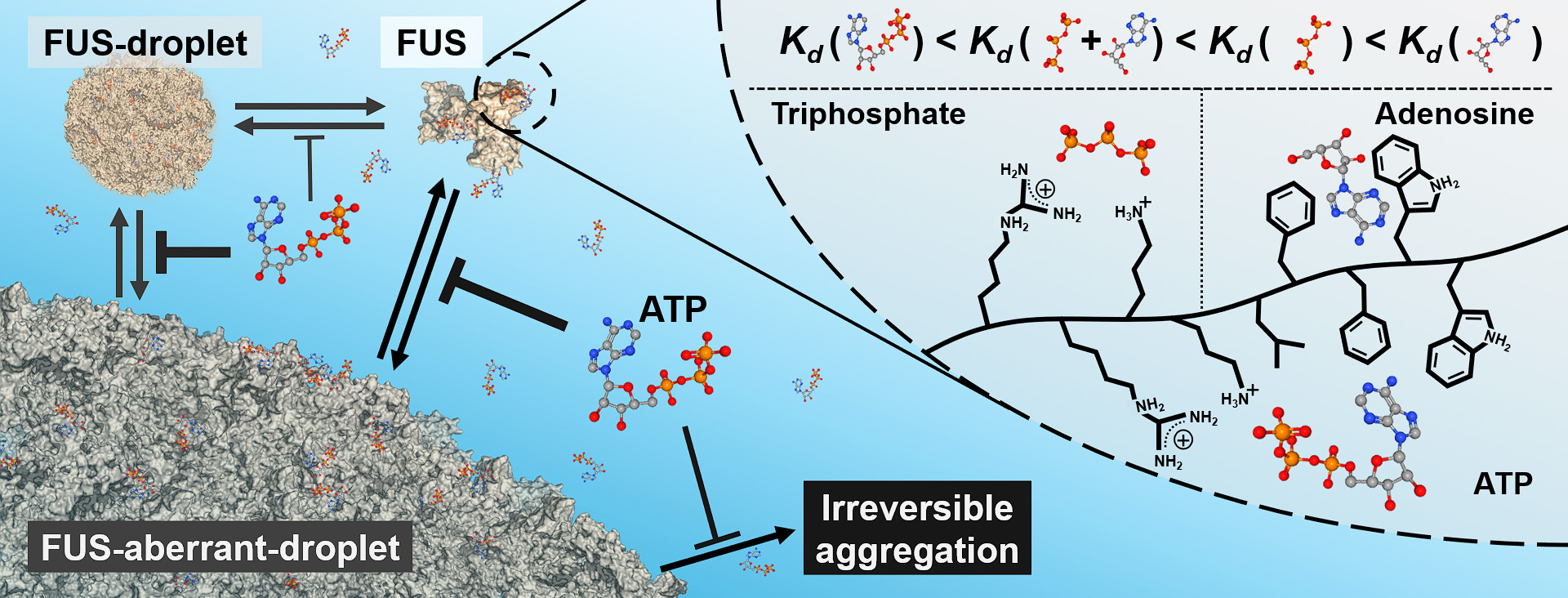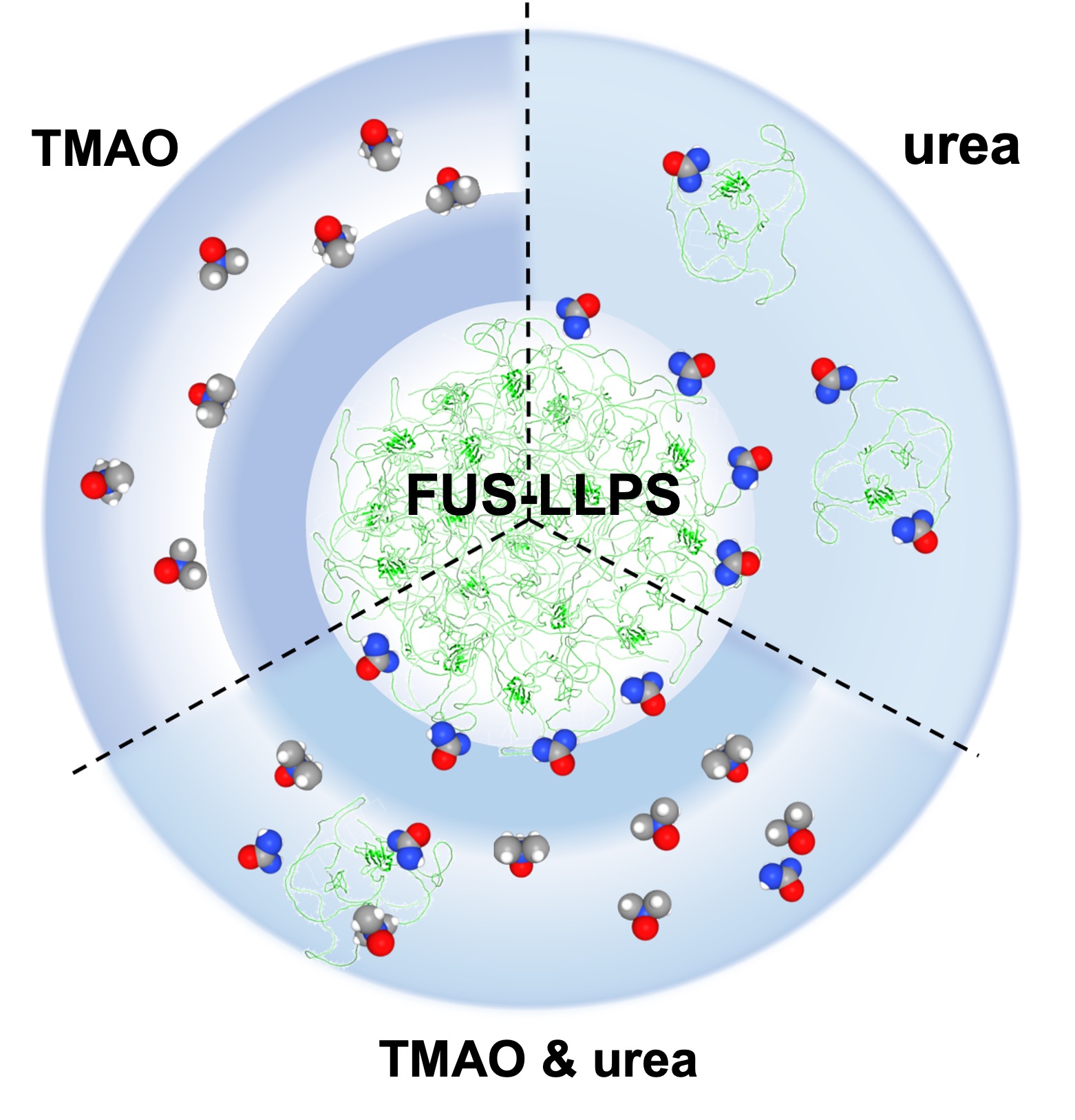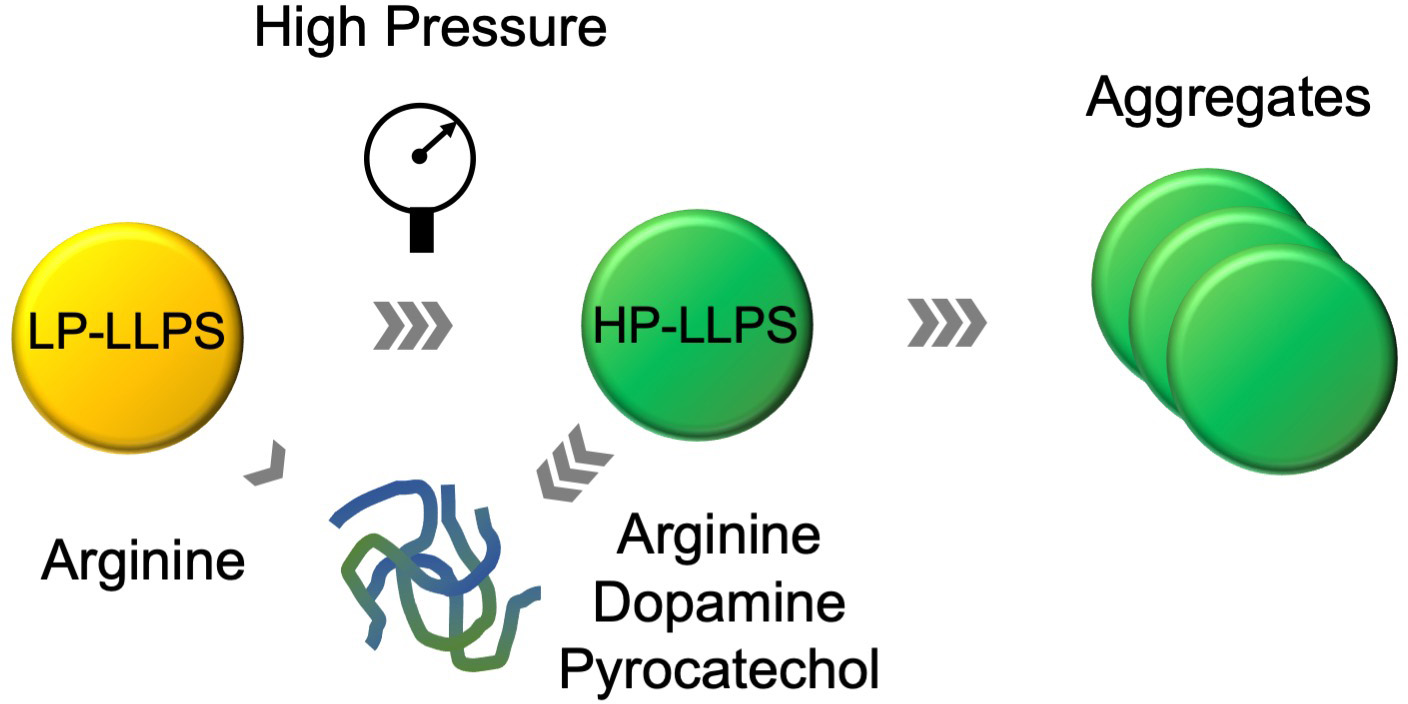<受賞> 日本生物物理学会若手奨励賞(日本生物物理学会、2006年度) NMR討論会若手ポスター賞(日本核磁気共鳴学会、2005年度)
<国際会議 招待講演 (2015以降)> 10th Asian Conference on High Pressure Research, online, 2021; High Pressure Bioscience and Biotechnology 2021 summit, online, 2021; Asia-Pacific NMR, 2019, Singapore; ICMRBS, 2018, Ireland; ISMAR Meeting, 2017, Canada; EUROMAR, 2016, Denmark; Protein NMR beyond, 2016, Japan; Asia-Pacific NMR, 2015, Hong Kong
<論文> *corresponding author
Keiji Kitamura, Itta Tsukui, Fuka Sasaki, Yutaro Shiramasa, Miyu Arayama, Manato Morishita, Ayano Oshima, Soichiro Kitazawa, Tomoshi Kameda, Ryo Kitahara*, ATP as a key modulator of fused-in-sarcoma phase separation and aggregation: Insights into amyotrophic lateral sclerosis pathogenesis, J. Mol. Biol. 437, 169295 (2025),(open access) https://doi.org/10.1016/j.jmb.2025.169295
白砂雄太郎、北原亮*、圧力軸で観るタンパク質の液液相分離と異常凝集、生物物理 65, 150-152 (2025)
坂口 裕子*,井之上 浩一,鈴木 健二,北原 亮, 小学生に向けた薬物乱用防止教室:薬学生交流を通した近隣大学としてのくすり教育, 薬学教育 8, 2024-041 (2024)
Sora Nozaki, Masanori Hijioka, Xiaopeng Wen*, Natsumi Iwashita, Junya Namba,Yoshiaki Nomura, Aoi Nakanishi, Soichiro Kitazawa, Ryo Honda, Yuji O. Kamatari,Ryo Kitahara, Kenji Suzuki, Masatoshi Inden, Yoshihisa Kitamura*, Galantamine suppresses α-synuclein aggregation by inducing autophagy via the activation of α7 nicotinic acetylcholine receptors, J. Pharm. Sci. 156, 102-114 (2024)
Giuseppe Pezzotti*, Tetsuya Adachi, Hayata Imamura, Saki Ikegami, Ryo Kitahara, Toshiro Yamamoto, Narisato Kanamura, Wenliang Zhu, Ken-ichi Ishibashi, Kazu Okuma, Osam Mazda, Aya Komori, Hitoshi Komatsuzawa and Koichi Makimura, Raman Spectroscopic Algorithms for Assessing Virulence in Oral Candidiasis: The Fight-or-Flight Response, Int. J. Mol. Sci. 25, 11410 (2024)(open access)
Keiji Kitamura, Ayano Oshima, Fuka Sasaki, Yutaro Shiramasa, Ryu Yamamoto, Tomoshi Kameda, Soichiro Kitazawa, and Ryo Kitahara*, Modulation of biomolecular liquid-liquid phase separation by preferential hydration and interaction of small osmolytes with proteins, J. Phys. Chem. Lett.15, 7620-7627 (2024)
Yutaro Shiramasa, Ryu Yamamoto, Norika Kashiwagi, Fuka Sasaki, Sawaka Imai, Mikihito Ike, Soichiro Kitazawa, Ryo Kitahara*, An aberrant FUS liquid droplet of amyotrophic lateral sclerosis pathological variant, R495X, accelerates liquid–solid phase transition, Scientific Reports 14, 8914 (2024)(open access)
布目 真梨, 近藤 雪絵, 鈴木 健二, 穐山 浩, 北原 亮, 薬学教育におけるレギュラトリーサイエンスの重要性:薬学生の食の安全に対する意識調査を通じて, 薬学教育 8, 2023-036 (2024)
北原亮、小池千恵子、圧力軸で見る生物の極限環境適応、細胞 55, 55-59 (2023)
Ryo Kitahara* and Tomoshi Kameda, Phase separation by biopolymers: basics and applications, Biophysics and Physicobiology, Advanced publication e190028 (2022)
Shujie Li, Takuya Yoshizawa, Yutaro Shiramasa, Mako Kanamaru, Fumika Ide, Keiji Kitamura, Norika Kashiwagi, Naoya Sasahara, Soichiro Kitazawa, Ryo Kitahara*, Mechanism underlying liquid-to-solid phase transition in fused in sarcoma liquid droplets, Phys. Chem. Chem. Phys. 24, 19346-19353 (2022)
Takuro Wakamoto, Junya Yamamoto, Sho Senzaki, Reina Koide, Soichiro Kitazawa, and Ryo Kitahara*, Amplification of the specific conformational fluctuation of proteins by site-specific mutagenesis and hydrostatic pressure, J. Phys. Chem.B 126, 1868-1875 (2022)
Ryo Kitahara*, Ryota Yamazaki, Fumika Ide, Shujie Li, Yutaro Shiramasa, Naoya Sasahara, Takuya Yoshizawa, Pressure-jump kinetics of liquid-liquid phase separation: Comparison of two different condensed phases of the RNA-binding protein, fused in sarcoma, J. Am. Chem. Soc. 143, 19697-19702 (2021) (open access)
李書潔、北原亮 水中におけるナフタレン骨格超分子チューブと1,4ジオキサンの複合体形成と圧力効果, 高圧力の科学と技術 Vol. 31, 91-95 (2021)
Shujie Li, Takuya Yoshizawa, Ryota Yamazaki, Ayano Fujiwara, Tomoshi Kameda, and Ryo Kitahara*, Pressure and temperature phase diagram for liquid-liquid phase separation of the RNA-binding protein fused in sarcoma, J. Phys. Chem. B 125, 6821-6829 (2021)
Ryo Kitahara*, Hiroshi Ueta, Uiko Tomiyasu, and Kensuke Egashira, Pressure tolerance of brine shrimp (Artemia), High Pressure Research 41, 109-117 (2021)
Shujie Li, Huan Yao, Tomoshi Kameda, Wei Jiang*, and Ryo Kitahara*, Volumetric properties for the binding of 1,4-dioxane to amide naphthotubes in water, J. Phys. Chem. B 124, 9175-9181 (2020)
三橋、北原 高圧力が蛋白質に及ぼす影響~圧力で早まるシアノバクテリアの概日時計~「化学と生物」 58, 579-584 (2020)
Takuro Wakamoto, Soichiro Kitazawa, Tomoshi Kameda, Ryo Kitahara*, Dynamic aspects of pressure and temperature-stabilized intermediates of outer surface protein A, Proteins 88, 1423-1433 (2020)
Takuro Wakamoto, Teppei Ikeya, Soichiro Kitazawa, Nicola J. Baxter, Mike P. Williamson, and Ryo Kitahara*, Paramagnetic relaxation enhancement-assisted structural characterization of a partially disordered conformation of ubiquitin, Protein Science 28, 1993-2003 (2019)
Mengjun Xue, Takuro Wakamoto, Camilla Keijlberg, Yuichi Yoshimura, Tania Aaquist Nielsen, Michael Wulff Risor, Kristian Wejse Sanggssrd, Ryo Kitahara*, and Frans AA Mulder*, How internal cavities destabilize a protein, PNAS USA 116, 21031-21036 (2019)
Ryo Kitahara*, Katsuyuki Oyama, Takahiro Kawamura, Keita Mitsuhashi, Soichiro Kitazawa, Kazuhiro Yasunaga, Natsuno Sagara, Megumi Fujimoto, and Kazuki Terauchi, Pressure accelerates the circadian clock of cyanobacteria, Scientific Reports 9, 12395 (2019)
Kiyoto Kamagata*, Eriko Mano, Yuji Itoh, Takuro Wakamoto, Ryo Kitahara, Saori Kanbayashi, Hiroto Takahashi, Agato Murata, and Tomoshi Kameda*, Rational design using sequence information only produces a peptide that binds to the intrinsically disordered region of p53, Scientific Reports 9, 8584 (2019)
Teshu Hori, Masashi Fukutome, Chiseto Maejima, Hiroki Matsushima, Kensuke Kobayashi, Soichiro Kitazawa, Ryo Kitahara, Katsunori Kitano, Kenta Kobayashi, Satoru Moritoh, Chieko Koike*, Gene delivery to cone photoreceptors by subretinal injection of rAAV2/6 in the mouse retina BBRC 515, 222-227 (2019)
Mike Williamson* and Ryo Kitahara, Characterisation of low-lying exited states of proteins by high-pressure NMR spectroscopy, BBA Proteins & Proteomics 1867, 350-358 (2019)
Soichiro Kitazawa, Yu Aoshima, Takuro Wakamoto, Ryo Kitahara*, Water-protein interactions coupled with protein conformational transition, Biophysical Journal. 115, 981-987 (2018)
Ryo, Kitahara*, Shun Sakuraba, Tomoshi Kameda, Sanshiro Okuda, Mengjun Xue, Frans A.A. Mulder, NMR-based determination of dioxygen binding sites in protein cavities, Protein Science 27, 769-779 (2018)
北原亮 「NMR法で観る圧力によるタンパク質の構造変化」 応用糖質科学Vol.7, No.4, 204-209 (2017)
Soichiro Kitazawa, Maho Yagi-Utsumi, Koichi Kato, Ryo Kitahara*, Interactions controlling the slow dynamic motions of ubiquitin, molecules 22, 1414 (2017).
Takahiro Kawamura, Takuro Wakamoto, Soichiro Kitazawa, Shun Sakuraba, Tomoshi Kameda, and Ryo Kitahara,* Analysisof O2-binding sites in proteins using gas-pressure NMR spectroscopy: outer surface protein A. Biophysical Journal 112, 1820-1828 (2017)
北原亮 「静水圧及びガス圧NMR法を用いたタンパク質の動的性質の研究」高圧力の科学と技術 Vol.27, No.1, 13-17 (2017)
Mengjun Xue, Ryo Kitahara, Yuichi Yoshimura, Frans A.A. Mulder*, Aberrant increase of NMR signal in hydrogen exchange experiments. Observations and explanation. Biochem. Biophys. Res. Comm. 478, 1185-1188 (2016)
Giovanni La Penna, Yoshiharu Mori, Ryo Kitahara, Kazuyuki Akasaka, and Yuko Okamoto*, Modeling 15N NMR chemical shift changes in protein backbone with pressure, J. Chem. Phys.145,085104 (2016)
Ryo Kitahara*, Yuichi Yoshimura, Mengjun Xue, Tomoshi Kameda & Frans A.A. Mulder*, Detecting O2 binding sites in protein cavities, Scientific Reports 6:20534 (2016) DOI:10.1038/srep20534
M. Yagi-Utsumi, T. Yamaguchi, R. Kitahara, and K. Kato*, NMR explanations of biomolecular systems with rapid conformational exchanges, Molecular Science of Fluctuations toward Biological Functions (Terazima, Kataoka, Ueoka, Okamoto Eds, Springer) (2016)
Koki Makabe*, Mitsuo Umetsu, Izumi Kumagai, Yoshigazu Tanaka, Hikaru Nakazawa, Ryo Kitahara, Soichiro Kitazawa, Ryosuke Sakurai, Zinc ion-binding activity of an anti-ZnO VHH antibody, 4F2, Chemistry Letters 44, 1309-1311 (2015)
Ryo Kitahara*, High-pressure NMR spectroscopy reveals functional sub-states of ubiquitin and ubiquitin-like proteins, High Pressure NMR (Akasaka & Matsuki Eds) 199-214 (2015)
Ryo Kitahara and Frans Mulder*, Is pressure-induced signal loss in NMR spectra for Leu99Ala cavity mutant of T4 lysozyme due to unfolding? PNAS E923 (2015)
Akihiro Maeno, Daniel Sindhikara, Fumio Hirata, Renee Otten, Frederick W. Dahlquist, Shigeyuki Yokoyama, Kazuyuki Akasaka, Frans A. A. Mulder, and Ryo Kitahara*, Cavity as a source of conformational fluctuation and high-energy state: High-pressure NMR study of a cavity mutant of T4 lysozyme, Biophysical J. 108, 135-145 (2015)
Soichiro Kitazawa, Tomoshi Kameda, Ayumi Kumo, Maho Yagi-Utsumi, Nicola J. Baxter, Koichi Kato, Mike P. Williamson, and Ryo Kitahara*, Close identity between alternative folded state N2 of ubiquitin and the conformation of the protein bound to the ubiquitin-activating enzyme, Biochemistry 53, 447-449 (2014)
Eiji Ohmae*, Yurina Miyashita, Shin-ichi Tate, Kunihiko Gekko, Soichiro Kitazawa, Ryo Kitahara, and Kunihiko Kuwajima, Solvent environments significantly affect the enzymatic function of E coli dihydrofolate reductase: Comparison of WT protein and active-site mutant D27E, Biochemica et Biophysica Acta 1834, 2782-2794 (2013)
Akemi Shodai, Toshifumi Morimura, Akemi Ido, Tsukasa Uchida, Takashi Ayaki, Rina Takahashi, Soichiro Kitazawa, Sakura Suzuki, Mikako Shirouzu, Takanori Kigawa, Yotaka Muto, Shigeyuki Yokoyama, Ryosuke Takahashi, Ryo Kitahara, Hidefumi Ito, Noriko Fujiwara, and Makoto Urushitani*, Aberrant self-assembly of RNA-recognition motif links to pathogenic conversion of TDP-43, J. Biol. Chem. 288, 14886-14905 (2013)
Soichiro Kitazawa, Tomoshi Kameda, Maho Yagi-Utsumi, Kenji Sugase, Nicola J. Baxter, Koichi Kato, Michael P. Williamson, and Ryo Kitahara*, Solution sturucture of the Q41N variant of ubiquitin as a model for the alternatively folded N2 state of ubiquitin, Biochemistry,52, 1874-1885 (2013)
Ryo Kitahara, Kazumi Hata, Hua Li, Mike Williamson, Kazuyuki Akasaka*, Pressure-inducedchemical shifts as probes for conformational fluctuations in proteins, Progress in NMR spectroscopy, 71, 35-58 (2013)
Kazuyuki Akasaka*, Ryo Kitahara, Yuji Kamatari, Exploring the folding energy landscape with pressure, Archives of Biochemistry and Biophysics 531, 110-115 (2013)
北原亮 高圧力NMR法で観る蛋白質の高エネルギー構造、NMR学会誌 3, 46-49 (2012).
Ryo Kitahara, Alana K. Simorellis, Kazumi Hata, Akihiro Maeno, Shigeyuki Yokoyama, Shohei Koide, and Kazuyuki Akasaka*, A delicate interplay of structure, dynamics and thermodynamics for function: A high pressure NMR study of Outer Surface Protein A, Biophysical Journal 102, 916-926 (2012)
Ryo Kitahara, Kazumi Hata, Akihiro Maeno, Kazuyuki Akasaka, Michael Chimeuti, Bertrand Garcia-Moreno, Martin A. Schroer, Christoph Jeworrek, Metin Tolan, Roland Winter, Julien Roche, Christian Roumestand, Karine Montet de Guillen, and Catherine A. Royer*, Structural plasticity of staphylococcal nuclease probed by perturbation with pressure and pH, Proteins 79, 1293-130 (2011)
Kazuhide Miyamoto*, Kayo Togiya, Ryo Kitahara, Kazuyuki Akasaka and Yoshihiro Kuroda, Solution structure of LC5, the CCR5-derived peptide for HIV-1 inhibition, Journal of Peptide Science 16, 165-170 (2010)
David J. Wilton, Ryo Kitahara, Kazuyuki Akasaka, and Mike Williamson*, Pressure dependent 13C shifts in proteins: Origins and application, J. Biol. NMR, 44, 25-33 (2009)
David J. Wilton, Ryo Kitahara, Kazuyuki Akasaka, and Mike Williamson*, Pressure-dependent changes in barnase on ligand binding reveals intermediate rate fluctuations, Biophysical. J. 97, 1482-1490 (2009)
北原亮、赤坂一之、極限環境下の蛋白質の構造と機能、材料58巻 449-455 (2009)
北原亮、可変圧力NMR法によるユビキチン様タンパク質に保存された構造揺らぎの発見、生物物理、49, 20-22 (2009)
北原亮、赤坂一之、可変圧力NMR法による蛋白質の準安定構造解析、高圧バイオサイエンスとバイオテクノロジー 2, 8-14 (2008)
Ryo Kitahara, Chenhua Zhao, Kohei Saito, Seizo Koshiba, Makoto Inoue, Takanori Kigawa, Shigeyuki Yokoyama, and Kazuyuki Akasaka*, Basic folded and low-populated locally disordered conformers of SUMO-2 characterized by NMR spectroscopy at varying pressures, Biochemistry 47, 30-39 (2008).
北原亮、蛋白質の準安定構造、生物物理 48, 41-45 (2008)
Shinichi Takayama, Yota Takahashi, Shinichi Mikami, Kiyohumi Irie, Shin Kawano, Yasuhiko Yamamoto, Hikaru Hemmi, Ryo Kitahara, Shigeyuki Yokoyama, and Kazuyuki Akasaka*, Local conformational transition of Hydrogenobacter thermophilus cytochrome c552 relevant to its redox potential. Biochemistry 46, 9215-9224 (2007).
北原亮、赤坂一之、揺らぐ蛋白質構造の解析―可変圧力NMRからのアプローチ、高圧力の科学と技術 17, 32-41 (2007).
Ryo Kitahara, Yoshiki Yamaguchi, Eri Sakata, Takeshi Kasuya, Keiji Tanaka, Koichi Kato, Shigeyuki Yokoyama, Kazuyuki Akasaka*. Evolutionally conserved intermediates between ubiquitin and NEDD8. J. Mol. Biol. 363、395-404 (2006).
Ryo Kitahara, Akira Okuno, Minoru Kato, Yoshihiro Taniguchi, Shigeyuki Yokoyama and Kazuyuki Akasaka*. Cold denaturation of ubiquitin at high pressure. Mag. Res. Chem. 44, s108-s113 (2006).
北原亮、横山茂之、赤坂一之、可変圧力NMRによる新しい蛋白質構造パラダイムの構築、分光研究55, 10-20 (2006).
Ryo Kitahara, Shigeyuki Yokoyama and Kazuyuki Akasaka*. NMR snapshots of a fluctuating protein structure. Ubiqutin at 30 bar-3 kbar. J. Mol. Biol. 347, 277-285 (2005).
Yuji Kamatari, Ryo Kitahara, Hiroyuki Yamada, Shigeyuki Yokoyama, and Kazuyuki Akasaka*. High pressure NMR spectroscopy for characterizing non-native conformers of proteins. Methods 34, 133-143 (2004).
Kazumi Hata, Ryohei Kono, M. Fujisawa, Ryo Kitahara, Yuji Kamatari, Kazuyuki Akasaka*, and X. Ying. High pressure NMR study of dihydrofolate reductase from a deep-sea bacterium Moritella profunda. Cell. Mol. Biol. 50, 311-316 (2004).
Ryo Kitahara and Kazuyuki Akasaka*. Close identity of a pressure stabilized intermediate with a kinetic intermediate in protein folding. Proc. Natl. Acad. Sci. USA 100, 3167-3172 (2003)
Ryo Kitahara, Minoru Kato, and Yoshihiro Taniguchi*. High-pressure 1H NMR study of pressure -induced structural changes in the heme environments of metcyanomyoglobin. Protein Sci. 12, 207-217 (2003)
Ryo Kitahara, Catherine Royer, Hiroaki Yamada, Mireille Boyer, Jean-Louis Saldana, Kazuyuki Akasaka, and Cristian Roumestand*. Equilibrium and pressure-jump relaxation studies of the conformational transitions of P13MTCP1. J. Mol. Biol. 329, 609-628 (2002).
Ryo Kitahara, Hiroaki Yamada, Kazuyuki Akasaka*, and Peter E. Wright. High pressure NMR reveals that apomyoglobin is an equilibrium mixture from the native to the unfolded. J. Mol. Biol. 320, 311-319 (2002).
Ryo Kitahara, Hiroaki Yamada, and Kazuyuki Akasaka*. Two folded conformers of ubiquitin revealed by high pressure NMR. Biochemistry 40, 13556-13563 (2001).
Ryo Kitahara, Sina Sareth, Hiroaki Yamada, Eiji Ohmae, Kunihiko Gekko, and Kazuyuki Akasaka*. High Pressure NMR reveals active-site hinge motion of folate-bound Escherichia coli dihydrofolate reductase. Biochemistry 39, 12789-12795 (2000).




